Zoom
Trash

Carbon emissions 'postpone ice age'. Image copyright Ittiz The next ice age may have been delayed by over 50,000 years because of the greenhouse gases put in the atmosphere by humans, scientists in Germany say.
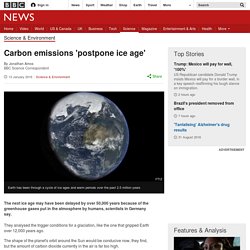
They analysed the trigger conditions for a glaciation, like the one that gripped Earth over 12,000 years ago. The shape of the planet's orbit around the Sun would be conducive now, they find, but the amount of carbon dioxide currently in the air is far too high. Earth is set for a prolonged warm phase, they tell the journal Nature. "In theory, the next ice age could be even further into the future, but there is no real practical importance in discussing whether it starts in 50,000 or 100,000 years from now," Andrey Ganopolski from the Potsdam Institute for Climate Impact Research said.
"The important thing is that it is an illustration that we have a geological power now. Earth has been through a cycle of ice ages and warm periods over the past 2.5 million years, referred to as the Quaternary Period. Planet rock. Climate Realist Marc Morano Debates Bill Nye the Science Guy on Global Warming. Climate Science: What You Need To Know. Global warming fact fiction and myth. GA Global Warming evidence. 7 Geoengineering Solutions That Promise To Save Humans from Climate Change.
Water scarcity is only one of the issues associated with rising global temperatures... photo: Mark N via flickr In case you missed the past years of debate, here's global climate change in a nutshell: Since human's began burning fossil fuels some 150 or so years ago atmospheric carbon dioxide levels have increased precipitously.
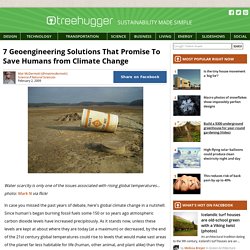
As it stands now, unless these levels are kept at about where they are today (at a maximum) or decreased, by the end of the 21st century global temperatures could rise to levels that would make vast areas of the planet far less habitable for life (human, other animal, and plant alike) than they are today. Enter geoengineering. In a worst case scenario it may be required, proponents of geoengineering say, for humans to intervene. Forget simply stopping or reversing deforestation and rehabilitating other natural carbon sinks. Spray Sulfate Aerosols Into The Atmosphere image: NASA The downside? Trap CO2 in Carbon Scrubbers.
Global warming. Global warming describes the current rise in the average temperature of Earth’s air and oceans.
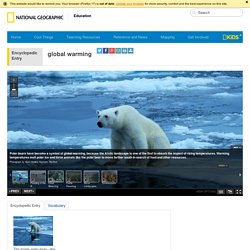
Global warming is often described as the most recent example of climate change. Earth’s climate has changed many times. Our planet has gone through multiple ice ages, in which ice sheets and glaciers covered large portions of the Earth. It has also gone through warm periods when temperatures were higher than they are today. Past changes in Earth’s temperature happened very slowly, over hundreds of thousands of years. In 1988, the World Meteorological Organization and the United Nations Environment Programme established a committee of climatologists, meteorologists, geographers, and other scientists from around the world. According to the IPCC’s most recent report (in 2007), Earth’s average surface temperatures have risen about 0.74 degrees Celsius (1.33 degrees Fahrenheit) during the past 100 years. Climate change causes. Global climate change causes and effects. The possible causes of climate change There are a couple of theories that relate to climate change and why it happens, but the finger points overwhelmingly towards human enhanced global warming given the current evidence collected by scientists.
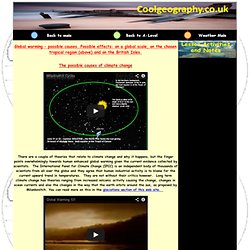
The International Panel for Climate Change (IPCC) is an independent body of thousands of scientists from all over the globe and they agree that human industrial activity is to blame for the current upward trend in temperatures. They are not without their critics however. Thinning Antarctic ice shelf could contribute to sea level rise, says study. The largest ice shelf on the Antarctic peninsula is thinning because of warmer ocean and air temperatures that are driving it towards a collapse that could contribute significantly to sea level rise, a new study has found.
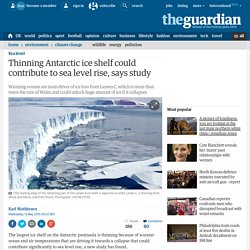
The study by the British Antarctic Survey (BAS) analysed the Larsen C ice shelf, which is two and a half times the size of Wales. The team looked at satellite radar imagery taken between 1998 and 2012 to find that Larsen C lost 4 metres of thickness. Until now scientists did not know whether the losses were coming from above or below.
The new work found both play a role, but the main driver is ice loss from below. Lead author Dr Paul Holland said: “What’s exciting about this study is we now know that two different processes are causing Larsen C to thin and become less stable.” The major loss occurred underneath the shelf where it floats on increasingly warm ocean currents. As they thin, ice shelves become prone to collapse. GF Responses to CC. The concept of a tipping point in climate change. Geofile climate change in vulnerable regions. Europe's changing climate. Global warming mediterranean.